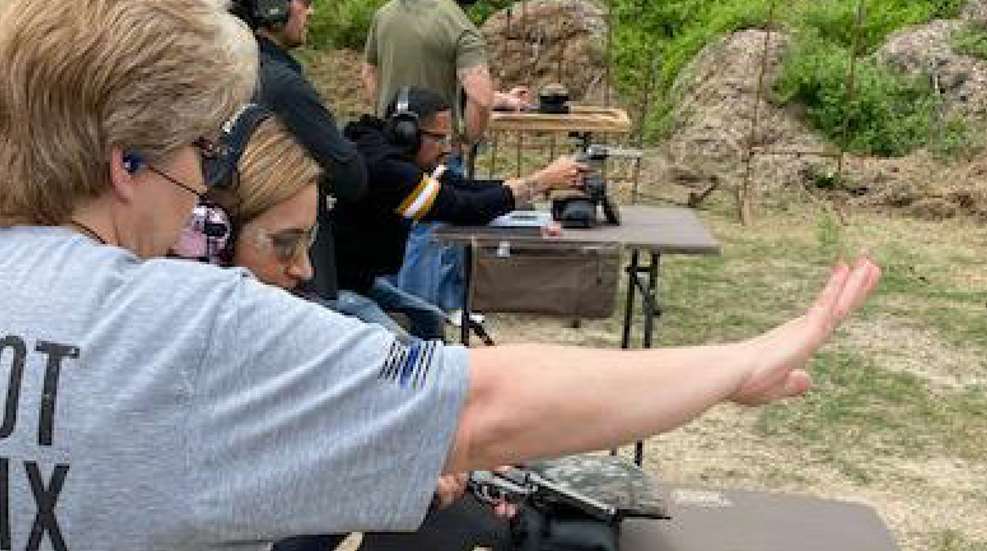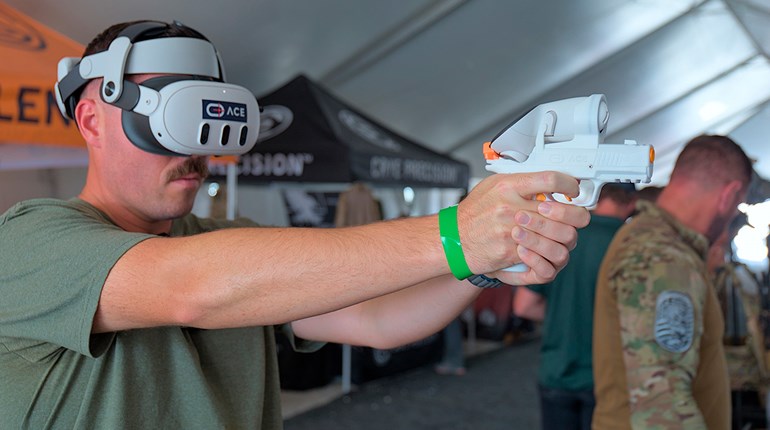
There are many benefits to using a .22-cal. firearm when conducting firearms training. This is especially true if you are training a beginner shooter who has never used a firearm. Most new shooters have no problem starting out with a .22 caliber. In fact, they are usually relieved that you have a small-caliber option for them to start with.
It is the “experienced” shooters that tend to balk at the idea of training with .22-cal. firearms. The .22 caliber is a great tool for improving a shooter’s skills. This caliber has low recoil, is inexpensive to shoot, and is extremely fun to shoot! All these factors combined mean the shooter who incorporates a .22 caliber firearm will practice longer and practice more often than a shooter that does not. More than likely, the shooter who incorporates a .22 caliber in his or her training will have better shooting skills and will be a better marksman.
Using a .22 caliber firearm when training a new shooter is suggested by the NRA Training Department and can be found within the NRA’s Basic Firearms Instructor Training Courses. I incorporate a .22 caliber firearm in my NRA Basic Pistol Course, NRA Basic Rifle Course, and whenever I am conducting a one-on-one training session with a student. For example, I start my NRA Pistol course with a single-action .22 caliber revolver, then progress to a semi-automatic .22 caliber pistol, then transition to the firearm they bring to class—9mm, .40 cal., .45 cal., etc.
At the beginning of every class I ask, “When you saw the description of the course, and you read we start out with a .22 caliber, how many of you were doubtful or somewhat insulted?” Most of the students in the class raise their hands. I tell them by the time the class is over, they will see the value of incorporating this small caliber into their training or if they are the ones training someone else—the value of adding this to their lesson plan.
Eliminates Flinch
The biggest hurdle to teaching a new shooter is getting past the “flinch.” Most new shooters show up to class or a training session with a pre-internalized flinch with large caliber firearms commonly used for self-defense. If you start a beginner shooter with a larger caliber on the range, you will spend much of your range time dealing with pushing the gun, closing of the eyes when they squeeze the trigger, anticipating recoil, and jerking the trigger. These can all be attributed to flinching.
Flinching is caused by fear—fear of the recoil, fear of the noise, and fear of the gun in general. By starting your student on a .22-cal. firearm, you can eliminate the fear of guns. If someone is coming to you to learn how to shoot, they have already begun to lose that fear on their own. Then .22 caliber helps in removing fears.
Some benefits to using .22 caliber firearms include low recoil and less noise. These are the two big culprits with a new shooter. This allows you to spend more time focusing on the fundamentals of shooting (aiming, breath control, hold control, trigger control, and follow through). Your student gets more quality time with their instructor. It also allows the instructor to easily transition their students to their preferred firearm and caliber. This leads to success and ultimately, a happy student.

Eliminates Distractions
Whatever you do to eliminate distractions, you are creating an environment conducive to learning. This allows your students to concentration on your instructions and on shooting. I have had students so distracted by the thought of shooting a gun, the recoil, and the noise that I could see they could not hear a word I was saying. I could see in their faces that they blocked everything out except the thought of shooting a gun. This creates safety issues that could result in a dangerous situation.
When I have a student that is worried about shooting because of what they have seen in the movies, what they have been told, or just misinformation, I start them out on a .22-cal. handgun. I let them get the feel of it and dry fire the gun several times. When they are comfortable with the feel of the gun and operating the action, I give them five cartridges. At a close distance to the berm, around 3 yards, I then have them shoot into the berm on my private range, with no target hung to distract them. After a couple of shots, the shooter becomes comfortable because I removed some big distractions like distance and a bullseye target to look at. Now they are ready to learn. Your students are now ready to concentrate on the 5 Fundamentals of Pistol Shooting.
The use of a .22 caliber is also a great tool for working with an individual that is experienced in shooting and coming to you to become a better shot. A low-caliber firearm is very useful in that it easily and visually verifies that your student is following the 5 Fundamentals of Shooting. Many “experienced” shooters have never been taught the correct way to shoot. Many times, by watching the shooter (and not the target where they are hitting), the instructor can see their student is skipping or improperly executing one of the 5 Fundamentals of Shooting. Once you see what your students are doing incorrectly, you can teach them the correct techniques.
Eliminates Excuses
My favorite thing about using a .22-cal. firearm in training is that it removes most of the excuses a student may offer if they cannot shoot their preferred caliber of gun very well. Almost every instructor has heard some declare, “I just can’t do this” or “This (shooting) is just not for me.” Starting your students on a .22-cal. gun negates these statements.
When you start your students on a .22-cal. firearm and they can concentrate on your instruction, they will almost always have a good grouping in the area they are aiming. When you transition your students from the .22 to their preferred firearm and they are not as accurate on target, and they start getting frustrated, this is the time when you hear the excuses. This is when you can confidently interject and remind them, “Yes you can do this, you just did it,” as you point out their success with the .22-cal. target. This usually settles their nerves and their shooting starts to improve.
Eliminates Failure
Lastly, incorporating a .22-cal. firearm in your training eliminates failure. If you are following the NRA method of training a new shooter, small caliber firearms increase success. You can teach anyone to shoot and be fairly accurate with a .22-cal. handgun at a relatively short distance from the target.
In other words, you are starting your student off with success not failure. Once they see that they can proficiently use a gun, they are more likely to transfer that success to their preferred gun or caliber. This makes your job easier as an instructor and it makes your student happy. Students who are successful are also more likely to continue working on their skills on their own. Success encourages another shooter to join our Second Amendment community.
The benefits of incorporating .22-cal. firearms allow you to get more training done in less time. This means your students will get more out of your training session. In other words, your students will be more comfortable with the safe handling of firearms and will be a better marksman after your class or training session than before they attended.
By the end of my NRA classes or one-on-one training sessions, all the students who were skeptical at the beginning of the class or training, now see the value of incorporating a .22-cal. firearm. This includes the most resistant student. I have never had a student say that they would not use a .22 caliber in their training after going through one of my classes.
Using .22-cal. firearms in my training classes had another unintentional positive consequence for the owner of the gun range where I train. Many of my students, especially those most resistant, leave the range and go to the store looking to purchase .22 caliber revolvers and pistols. He cannot keep .22s in stock!














































